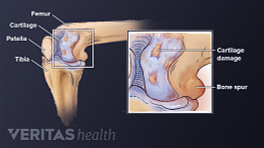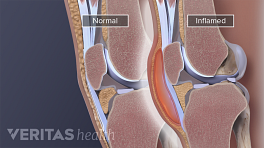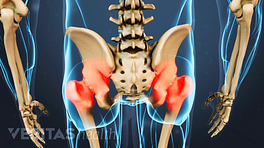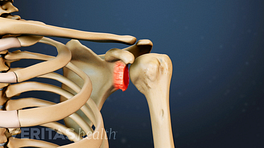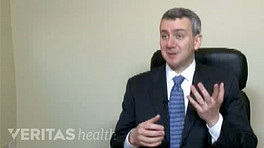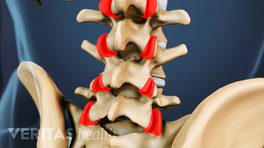In order to understand joint pain, it’s important to understand the various components that make up a joint. Basically a joint is the articulation between two bony surfaces that allows for movement, in most cases, at those two surfaces. The joint itself is comprised of cartilage substance which allows for smooth and gliding motion at that joint. There’s also a capsule which is a covering around the cartilage and around the joint which helps stabilize the joint itself. On the inside of this capsule is the synovial membrane, and a synovial membrane makes synovial fluid, which many people have heard of. The synovial fluid acts to lubricate the joint itself. And this combined structure allows for easy motion, flowing motion, and increased stability.
There are also other structures of the joint outside of the capsule, outside of the synovium, and outside of the joint which help stabilize the structure, which include various ligaments (which attach bone to bone) and tendons (which attach muscle that crosses the joint to the bone). There can also be fascia, and Bursas, which bursas allow for decreased friction usually between a tendon and another tendon or a tendon and the bone. So that way when muscles cross joint lines, and tendons cross joint lines, there’s decreased friction at that joint.
Now joint pain can be caused from various conditions. One condition that people often talk about is rheumatoid arthritis. What is rheumatoid arthritis? It’s a chronic inflammatory disease that affects the synovial lining, remember that’s the lining on the inside of the capsule covering the joint, and that synovial lining makes the synovial fluid. This is an autoimmune disease. What that means is that, in this case, the body is mistaking its own parts as things it needs to attack. So it forms immunoglobulins, which then attack and cause damage to our own body structures.
Symptoms of rheumatoid arthritis would include inflammation and swelling of the synovial tissue, the joints may become painful, and stiff, there could be swelling of those joints.
One important characterization would be that the inflammation, the pain, the swelling is often symmetric; it happens on both sides. This is in contrast to osteoarthritis. Remember osteoarthritis is wear and tear of a joint. So this would usually happen in the joint that’s more used. So for example, if you are right-handed, you’re going to get more wear and tear over a lifetime of the right hand, the right wrist, the right fingers, the right shoulder, the right elbow, and so on, because that’s more often used, because that’s your dominant hand. Whereas rheumatoid arthritis, because it’s an inflammatory systemic disease, it doesn’t care which side it chooses, and it will affect often times both sides.
Now, as we just mentioned, joint pain can be caused by wearing down of the cartilage. This is now osteoarthritis, which is different than the rheumatoid arthritis. This is the most common condition that causes joint pain.
Other causes of joint pain can include the muscles, the tendons, the ligaments, and the bursa. The muscles, tendons, the ligaments, and the bursa are all structured, as we mentioned, that are located outside of the joint itself. It’s important to realize that all of these structures, everything that has been mentioned, work together as a unit in order to allow for joint motion. When a problem occurs in one area, it can often mean that, it can have a cascade effect and cause problems in other areas. For example, if you have arthritis, which is wear and tear of the actual joint itself, the cartilage itself, and you start developing a limp because of the pain associated with that arthritic condition, you may then start to put stress on the tendons, the muscles, and the ligaments not only of that joint but in joints in the adjacent area. So there can be a cascade effect. And this is why it’s very important that when you have pain you get it addressed sooner rather than later because of this domino effect, the pain in one area can cause pain in another area that could have been avoided had the primary area been treated.


